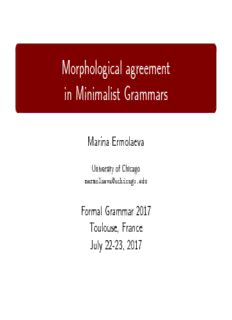
Morphological agreement in Minimalist Grammars PDF
Preview Morphological agreement in Minimalist Grammars
Morphological agreement in Minimalist Grammars Marina Ermolaeva UniversityofChicago [email protected] Formal Grammar 2017 Toulouse, France July 22-23, 2017 • Minimalist Grammars (MGs, Stabler 1997): formalization of Chomsky’s Minimalist Program • Goal: extend MGs with morphological features and operations on them Introduction AgreementinMGs Casestudy:Icelandicdativeintervention Discussion Overview • Agreement: morphological manifestation of dependencies between words He walks. There seems to have arrived a man. • Goal: extend MGs with morphological features and operations on them Introduction AgreementinMGs Casestudy:Icelandicdativeintervention Discussion Overview • Agreement: morphological manifestation of dependencies between words He walks. There seems to have arrived a man. • Minimalist Grammars (MGs, Stabler 1997): formalization of Chomsky’s Minimalist Program Introduction AgreementinMGs Casestudy:Icelandicdativeintervention Discussion Overview • Agreement: morphological manifestation of dependencies between words He walks. There seems to have arrived a man. • Minimalist Grammars (MGs, Stabler 1997): formalization of Chomsky’s Minimalist Program • Goal: extend MGs with morphological features and operations on them Introduction AgreementinMGs Casestudy:Icelandicdativeintervention Discussion Overview Introduction 1 Agreement in MGs 2 Case study: Icelandic dative intervention 3 Discussion 4 DP this [D, num:(cid:15)] NP probe ... boy [N, num:sg] goal Introduction AgreementinMGs Casestudy:Icelandicdativeintervention Discussion Agreement in Minimalist Syntax (Adger 2010) • Syntax is driven by feature checking/valuation • Merge and Move: • operate on categorial features (T, V, D, N...) • build new structure • Agree: • targets morphosyntactic features (num, per, case...) • creates dependencies within existing structure Introduction AgreementinMGs Casestudy:Icelandicdativeintervention Discussion Agreement in Minimalist Syntax (Adger 2010) • Syntax is driven by feature checking/valuation • Merge and Move: • operate on categorial features (T, V, D, N...) • build new structure • Agree: • targets morphosyntactic features (num, per, case...) • creates dependencies within existing structure DP this [D, num:(cid:15)] NP probe ... boy [N, num:sg] goal Introduction AgreementinMGs Casestudy:Icelandicdativeintervention Discussion Agreement in Minimalist Syntax (Adger 2010) • Syntax is driven by feature checking/valuation • Merge and Move: • operate on categorial features (T, V, D, N...) • build new structure • Agree: • targets morphosyntactic features (num, per, case...) • creates dependencies within existing structure DP this [D, num:(cid:15)] NP probe ... boy [N, num:sg] goal Introduction AgreementinMGs Casestudy:Icelandicdativeintervention Discussion Agreement in Minimalist Syntax (Adger 2010) • Syntax is driven by feature checking/valuation • Merge and Move: • operate on categorial features (T, V, D, N...) • build new structure • Agree: • targets morphosyntactic features (num, per, case...) • creates dependencies within existing structure DP this [D, num:sg] NP probe ... boy [N, num:sg] goal ∪ {=>f | f ∈ base} (head movement selectors) ∪ {∗f | f ∈ base} (“persistent” licensees) • A set of lexical items: Lex ⊂ Σ∗ ×Syn∗, where Σ is a set of pronounced segments • Two structure-building operations: merge and move Introduction AgreementinMGs Casestudy:Icelandicdativeintervention Discussion Minimalist Grammars (Stabler 1997) • A set of syntactic features: Syn = base (categories) ∪ {=f | f ∈ base} (selectors) ∪ {+f | f ∈ base} (licensors) ∪ {-f | f ∈ base} (licensees)
Description: